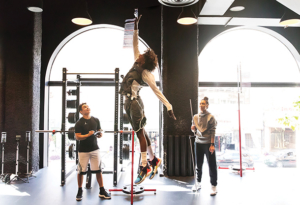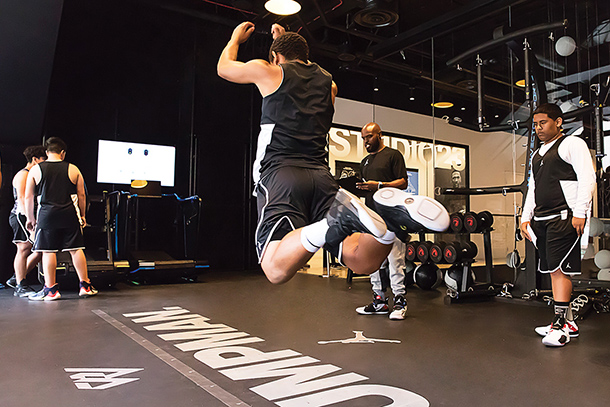As technology continues to advance, so too does sports science. Today, practitioners are expected to use technology and data to improve athletic performance and reduce player injury.
Translation of technology and data into more effective and efficient care for athletes requires not only foundational work that identifies appropriate applications for technology, but also a workforce of educated professionals who can implement effective technologydriven strategies, according to Susan Sigward, PhD, PT, associate professor of research physical therapy in the USC Division of Biokinesiology and Physical Therapy.
To meet the needs of the ever-evolving field, USC has developed a new master’s degree in biokinesiology with a sports science emphasis. The program’s first class of four students graduated in early May.
“Our traditional master’s program instructs students to become researchers and then they typically pursue a PhD,” said Sigward, who serves as director of the new sports science program. “But with the boom in the ability to capture large amounts of data, people are looking for more master’s-level trained individuals who have expertise in areas related to sports or activity performance.”
Born out of tech boom
Advancement in technology is solely responsible for the rapidly expanding field of sports science, according to E. Todd Schroeder, PhD, associate professor of clinical physical therapy. While the study of sports science has been around for many years, it wasn’t until the past 10 years that the field began to explode.
“This was largely due to the development of accurate wearable devices that include GPS, accelerometry, gyroscopes, heart rate, electrocardiogram and electromyography designed to fit into small devices or fabrics with improved battery life,” Schroeder said. “We now have the ability to gather data during practices and games that allows us to optimize the athlete’s training to improve performance while reducing fatigue and injury.”
One of the first
The new master’s program was created when biokinesiology faculty members recognized the need for graduates to be able to jump right into these careers.
“Many sports science programs focus on the strength and conditioning aspects of improving athlete performance,” Schroeder explained. “We wanted to offer a program that also included using new technology, data analytics and applied internships to prepare students to be a part of a comprehensive team that improves health and performance of athletes at all levels.”
The program provides students with a solid understanding of physiological, biomechanical and neurological basis of movement while giving them the advanced skills necessary to excel in a specialized area related to sports and exercise. Graduates will have a theoretical and practical understanding of the concepts and tools used in sports performance assessment and interpretation with respect to injury, injury risk and optimal performance.
The sports science emphasis differs from the traditional master’s in biokinesiology degree in that it is designed to teach students how to apply scientific methods in practice. Students still learn the fundamentals of biokinesiology — concepts such as biomechanics, exercise physiology and motor control and behavior — but additional electives (and an internship) help them focus on how to apply those in practical situations.
“Most of the people looking for this sort of education in the U.S. are enrolling in long-distance programs or going to Australia, where the modern realm of sports science started in the 1960s,” Sigward explained. “USC is one of the first programs in the United States that’s truly calling itself a graduate program in sports science.”
L.A.: Land of opportunity
Nicole Schwery, MS, one of the program’s first graduates, said one of the reasons she chose to attend USC is because of its reputation as a leader in the physical therapy field, allowing her more opportunity than ever.
“There are so many opportunities with different sports teams where you can apply what you learn in the classroom to a real scenario that wouldn’t be possible anywhere else,” she said.
Another difference of the new program is that students must complete an internship, which allows them to have applied experience in settings that range from college and professional sports teams to biomedical and tech companies. “After learning the methodologies and understanding how to analyze the data, we feel it is important for our students to work with sports teams and tech companies to apply what they have learned,” Schroeder said.
Through relationships the division has developed with tech companies and collegiate/professional sports teams in L.A., students have a wide range of options regarding where to perform their internships. These internship settings are similar to what a student would seek after completing their degree, giving students an opportunity to make valuable connections before they even graduate.
The Flight Lab
And because of a brand-new partnership, they also have access to Jumpman LA, a 25,000-square-foot facility in Downtown L.A. that is home to the Jordan brand and offers shopping, customization and training. The Flight Lab (located on the store’s second floor) provides students with a space to work on sports science projects while giving back to the surrounding community.
The project came about through Malcolm Jones, MS, who worked part-time as a brand ambassador for the Jordan brand.
“I introduced Drs. Sigward and Schroeder to one of my bosses from the brand to see if they would be interested in sponsoring science work at one of our USC labs,” said Jones, who is now a manager at the Flight Lab and a PhD student in biokinesiology.
“Our goal is for Jumpman LA to be a hub where our master’s students come in, define a project they want to do and implement it,” Sigward said. “We’ll also be hosting youth education sessions.
“With this equipment, they might test 100 basketball players and investigate the differences in how they jump or land,” Sigward said. “They have a virtual reality treadmill, and one of the projects they’re doing is looking at the metabolic cost of doing a workout on the treadmill with virtual reality versus just doing it normally.”
Focus on the community

Eighth grader Jaden Rashada tests his vertical jump, which was nearly 30 inches. (Photo/Nate Jensen)
The space offers free services to the community, such as after school programs, weekly fitness classes, yoga sessions and basketball or football training.
“The Jordan brand wants to push activities and programs for the community,” Jones explained. “They like to integrate and help develop a sense of community. We treat everybody like they’re a professional athlete.”
By hosting adolescents from nearby communities, the Flight Lab not only provides a fun, hands-on learning environment, it also shows sports-loving teens that there are more career options in the sports world than striving to become a professional athlete.
“There’s a translation piece of getting the science to them, letting them take ownership of their own bodies and seeing what other jobs in sports exist,” Jones said.
Equipment available at the Flight Lab includes a virtual reality treadmill, a Simi Motion capture system, BerTec force plates, NormaTec boots and a metabolic testing setup — tools that allow student athletes to compare their athletic performance data to their favorite athletes.
According to Richard Mercer, MS, another member of the first graduating class, the Flight Lab provides an ideal space for master’s students to be curious and test their ideas.
“If you want to test a certain technology, do it at the Flight Lab.” he said. “If you want to hypothesize about a theoretical idea for a project, do it at the Flight Lab. It will be a great space for future students entering the sports science program to build their knowledge and skills.”
Potential career paths
The sports and performance science field is rapidly growing and the outlook for jobs is bright.
“In the past few years, we’ve gotten calls from professional sports teams and tech companies from around the country, asking if we have graduating students who might be interested in a sports science position,” Schroeder said. Possible career paths for graduates include working for companies that create sports assessment technology, working alongside a professional sports team or providing rehabilitation in an applied training or clinical setting.
“For a sports team, the sports scientist is the expert liaison between the coaches, strength and conditioning staff and the athletic medicine team,” Schroeder said. “They need to be knowledgeable about many disciplines, know how to analyze data collected with advancements in technology and communicate this information to the team, making it actionable for improving health and performance of the athletes.”
He added, “Great sports scientists in the tech field will combine their education in biokinesiology and their applied knowledge of the human body to help engineers develop new technology that accurately measures human movement and physiology.”
Connected with the right people
Another member of the first graduating class, Karen Hyunji Lee, MS, plans to work as a research associate at Stayhealthy, a technology company that creates web-enabled health care monitoring products, where she performed her internship. She credits the program at USC with helping her transition from a temporary graduate student intern to a permanent position. “My experience as a part-time researcher prepared me to hit the ground running for my full-time job after graduation,” she said.
“There are a number of opportunities within the umbrella of sports science,” Lee said. “It is important for students to gain exposure to a wide range of these fields to find the one they are passionate about. The program is led by excellent faculty members who guide students to finding the field that suits them best and connects them to the right people.”
For more information on the Master’s of Biokinesiology with Sports Science Emphasis, visit sportscience.usc.edu.
— Michelle McCarthy


